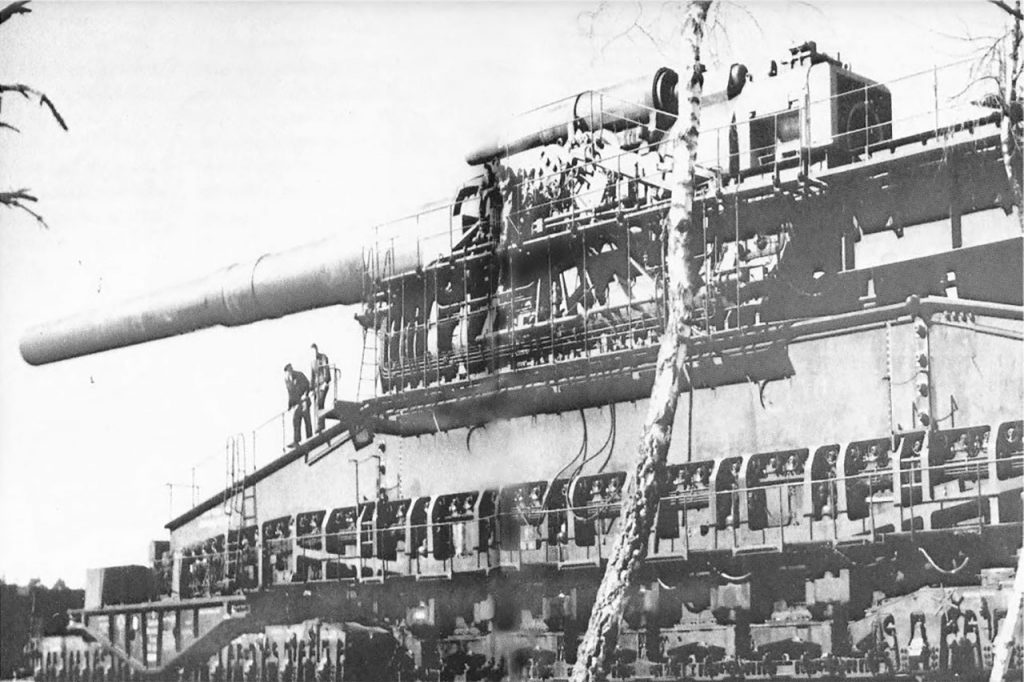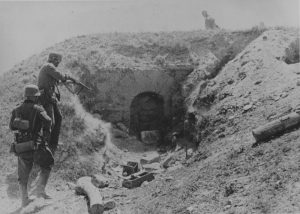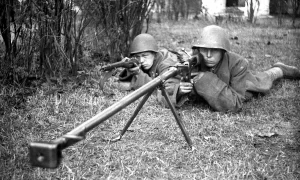June 1942 Second assault 2nd Assault on Sevastopol
The land defense of Sevastopol was based on a series of large permanent structures (artillery forts ). To destroy the forts, the Germans used siege artillery of large calibers. In total, over 200 batteries of heavy artillery were located on a perimeter of 22 km. Most of the batteries consisted of conventional large-caliber field artillery, including the 210mm heavy howitzers , and the 300mm and 350mm heavy howitzers from WWI . Super-heavy siege weapons were also used:
- howitzer Gamma Mörser – 420 mm;
- 2 self-propelled mortars Karl – 600 mm.
Sevastopol also the first time were used superheavy 800 mm gun class ” Dora “. A gun with a total mass of more than 1000 tons was secretly delivered from Germany and placed in a special shelter, carved out in a rock mass in the Bakhchisarai region . The gun entered service in early June and fired a total of fifty-three 7-ton rounds. Dora’s fire was directed against forts BB-30 , BB-35, as well as underground ammunition depots located in rock massifs. As it turned out later, one of the shells pierced a rock mass 30 m thick. After this siege, Dora was used only once – when suppressing Warsaw Uprising in October 1944. Anti -aircraft 88-mm guns and rapid-fire 20-mm and 37-mm anti-aircraft guns, which fired with direct fire, were widely used against less fortified bunkers and bunkers .


Initially, the German command planned to start the assault on November 27, 1941, but due to weather conditions and the actions of the partisans, by November 17, 50% of the carriage transport and 4 steam locomotives out of 5 at the disposal of the 11 army were out of order, as a result of which the assault began December 17. After massive artillery preparation, the German units launched an offensive in the valley of the river. Belbek. The 22nd Lower Saxon and 132nd Infantry Divisions were able to break through into the fortified zone south of the valley, the 50th and 24th divisions suffered heavy losses and were unable to advance further.
After the landing of the Soviet landing in Feodosia, the German command was forced to transfer the 170th Infantry Division to the Kerch Peninsula, while the rest of the units continued to storm the fortress. German troops were able to approach Fort Stalin. However, by December 30, the offensive capabilities of the 11th Army had dried up. According to Manstein, the withdrawal of German units to the initial lines was his initiative, Soviet historiography claims that German troops were driven out by a series of counterattacks. Combat Map.
The last assault
For the summer assault, the German command as part of the 11th Army used the forces of six corps:
- 54th Army : 22nd , 24th , 50th , 132nd Infantry Divisions;
- 30th Army : 72nd , 170th Infantry, 28th Light Division;
- 42nd Army : 46th Infantry, Motorized Brigade of K. von Groddeck ;
- 7th Romanian, General F. Mitranescu : 10th, 19th Infantry, 4th Mountain Division, 8th Cavalry Brigade ;
- Romanian Mountain: 1st Mountain, 18th Infantry Division, 4th Mountain Brigade;
- 8th Aviation Corps .
The 42nd Army and 7th Romanian Corps were located on the Kerch Peninsula , their units were supposed to be used to replace the divisions that would suffer the greatest losses. 46th Infantry and the 4th Mountain Division in the second phase of the assault replaced the 132-th and 24-th Division. Anticipating heavy losses, the command of the 11th Army demanded an additional three infantry regiments, which were used in the last stage of the battle . For ground battles, several anti-aircraft artillery regiments of the 8th Aviation Corps were used… The army also had the 300th separate tank battalion, three self-propelled gun battalions, 208 batteries of guns (not counting anti-aircraft ones), including 93 batteries of heavy and superheavy guns. Assessing the power of artillery, Manstein said: ” In general, in the Second World War, the Germans never achieved such a massive use of artillery .” Comparing the forces of the parties in manpower, he twice asserts that quantitatively the German-Romanian army and the Soviet garrison were equal.
The book “Lost Victories” contains information at the disposal of the headquarters of the 11th Army about the Soviet forces located in Sevastopol: Headquarters of the Primorskaya Army, 2nd, 95th, 172nd, 345th, 386th, 388 1st Infantry Divisions, 40th Cavalry Division, 7th, 8th, 79th Marine Brigade. According to Manstein, 7 Soviet divisions and 3 brigades are “at least equal” to 13 divisions, an air corps and 3 brigades (not counting individual infantry and artillery regiments, and numerous units that were part of each of the 6 corps directorates).
The assault began on June 7 . The stubborn struggle and counterattacks of the defenders continued for more than a week. In the attacking German companies, an average of 25 people remained. War map (until the morning of June 30) .
- On June 2, on the way to Sevastopol, the tanker “Mikhail Gromov” sunk while escorting two combat battalions and four SKA.
- On June 8, ships were sunk – the hydrographic vessel and the destroyer “Perfect” (previously blown up at a minefield).
- On June 10, ships were sunk – the transport ” Abkhazia ” and the destroyer “Svobodny” (see photo).
- On June 13, ships were sunk – transport ” Georgia ” (when approaching the Mine Pier), TSC -27, SKA -092.
The turning point came on June 17 : in the southern sector, the attackers took up a position known as the “eagle’s nest” and reached the foot of Sapun Mountain .


In the northern sector, on June 17, the Stalin fort and the foot of the Mekenziev heights were captured . On this day, several more forts fell, including the BB-30 battery (as the Germans called it, Fort “Maxim Gorky-1”).
For June 18-23, despite the transfer to the northern section of a fresh replenishment (arrived on June 12-13 on the cruiser Molotov and destroyers) of 2,600 people, all Soviet troops above the Northern Bay were either destroyed or surrendered after all the ammunition had been used up, or continued to fight back in isolated fortifications and shelters (such as the Konstantinovsky Fort , which the last defenders left by swimming on the morning of June 24).
- On June 18, supply ships were damaged (both by aviation and artillery), including the leader “Kharkov” , and the cruiser ” Comintern” refused to enter the bay. At night, the ambulance transport “Bialystok” (using its own speed of 14 knots) was the last of the transport ships to enter the Northern Bay and moored at the refrigerator. In the morning, due to shelling, he was forced to interrupt unloading and, with two holes below the waterline, went out to sea, having on board about 400 wounded and less than 100 evacuees. At 2 am on June 19, south of Cape Fiolent, it was sunk by enemy TKA .
From that moment on, German artillery could shell the Northern Bay , and the supply of reinforcements and ammunition in the required volume became impossible. Supply began to be carried out by high-speed leaders (the leader “Tashkent” last arrived in Sevastopol on the night of June 26-27 with reinforcements and ammunition, took out more than 2,100 people and fragments of the famous panorama from the city, while undergoing continuous attacks by 90 aircraft from 5 to 9 am, received serious damage and lost speed near Taman – towed to Novorossiysk) and small high-speed ships (such as BTShch and SKA ), submarines in Karantinnaya, Streletskaya, Kamyshovaya bays and Cape Chersonesos.
However, the inner ring of defense was still preserved, the engineering fortifications of Sevastopol were large and their frontal assault did not bode well for the Germans.
On June 27, all the anti-aircraft artillery of the SOR (except for the Kherson airfield) was left without ammunition, the onslaught of enemy aviation increased many times – even the ammunition brought in at night was difficult to deliver to the front line. The guns without shells began to pull to the areas of the bay Striletska to bay Kazachyem (north cape Chersonese ).
Manstein decided to attack the inner ring not head-on from the southeast, but to the flank from the north, for which he had to cross the Northern Bay. The southern coast of the bay was heavily fortified, and the landing seemed almost impossible, which is why Manstein decided to bet on the surprise. On the night of June 28-29, at 2 am, without dedicated artillery preparation, the advance units of the 30th corps in inflatable boats (see photo) secretly crossed the bay under the cover of a smoke screen and suddenly attacked in 4 places ( 17 boats and one boat were sunk). They managed to gain a foothold only in the Volovya Balka area, then go up to the Suzdal Mountain and land another landing in the Kilen-Balka area. By noon, the village of Inkermanwas lost, the ammunition depots in it were blown up during the retreat, blocking the passage along the bay along the railway. The entire front shifted to the west of Kilen-Balka, along the Kamchatka Redoubt – Victoria Redoubt.
On June 29, at about 3 am, the Germans also tried to land troops on Cape Chersonesos . 12 motor schooners from Yalta were found near Cape Fiolent and 9 of them were sunk by the 18th coastal battery , despite the demonstration of a false landing by enemy torpedo boats to the east, near the St. George Monastery (with the explosion of a boat filled with explosives near the coast).
On June 29, at 16-17 o’clock, due to a lack of ammunition, the artillery of the SOR ceased fire in the area of Mount Suzdal , Dergachi farm, and in the Sapun-gora area (most of the 386th rifle division fled from there due to powerful shelling in the morning) – on a breakthrough occurred in the key sector of the second line of defense. By evening, the enemy occupied these areas, dragged in artillery and was able to shell the entire city. This was a key moment, since the entire area of Sevastopol and Cape Chersonesos is being shot from Sapun Mountain .
On June 30, only 5 batteries with a small supply of shells remained in the coastal defense. The army had 1,529 medium caliber rounds and some anti-tank rounds. All rear divisions of the army and navy began to destroy supplies and funds, the transportation of goods was stopped, trucks stood randomly along the coast of the Chersonesos peninsula, where they were then destroyed (see photo ).
Evacuation
On June 30, Malakhov Kurgan fell . By this time, the defenders of Sevastopol began to run out of ammunition, and the commander of the defense, Vice Admiral Oktyabrsky, received permission from the headquarters of the Supreme Command for evacuation.
The evacuation of individual formations continued until at least July 4, 1942. On July 1, 1942, at a meeting of the command of the SOR, an order was received from the Headquarters of the VK to evacuate the commander of the coastal army. The commander of the Primorsky Army, General Petrov, was evacuated on the Shch-209 submarine on the evening of July 1. The command of the remaining garrison was entrusted to the commander of the 109th rifle division, Major General P. G. Novikov, who commanded the defense and evacuation cover until July 8, 1942. On July 9, 1942, Novikov tried to evacuate MO-112, but collided with 5 enemy torpedo boats and was captured during the ensuing battle.
The evacuation of the high command began with the help of aviation. 13 PS-84 aircraft took 222 chiefs and 49 wounded to the Caucasus. About 700 command personnel were taken out by submarines. Several thousand more were able to leave on light craft of the Black Sea Fleet.
On July 1, the resistance of the defenders of the city itself ceased, on the night of July 2, armored battery No. 35 was blown up , on which there were no shells, but which was fighting and at that time was not captured by the enemy. Further, the resistance was spontaneous, except for Cape Chersonesos and separate scattered centers, in which individual groups of Soviet soldiers continued to fight until July 9-12. The 81st separate tank battalion on July 2 in the area of the Cossack Bay lost the last 4 vehicles in battle, and the last T-26 tank (with 15 rounds) from the 125th separate tank battalion (Major Listobaev with a political instructor and 5 soldiers) entered the last battle on July 3 in the Cossack Bay area.
From the certificate of the head of the department of special departments of the NKVD of the USSR V.S.Abakumov dated July 1, 1942:
“In a conversation with my Commander of the Black Sea Fleet, Comrade Oktyabrsky, who is in Novorossiysk, reported about the situation in Sevastopol: on the night of June 30 to July 1, the enemy broke into the city and occupied the following areas: the station, storichesky Boulevard, Khersones the airfield, etc. The remaining soldiers fight heroically, do not surrender, and destroy themselves in a hopeless situation.Sevastopol, as a city, no, it is destroyed ”
– CA FSB of Russia. F. 14. Op. 4. D. 561. L. 4
The remnants of the Maritime Army retreated to Cape Chersonesos, where they resisted until July 8, 1942. Part of the soldiers and commanders surrendered after a powerful shelling, bombing and dismemberment of the defense between the Cossack Bay and the armored battery No. 35 at 14-15 hours on 4 July. German general Kurt von Tippelskirch, who was at that time on the Don , announced the capture of 100 thousand prisoners, 622 guns, 26 tanks and 141 aircraft at Cape Chersonesos. Manstein, who directly commanded the 11th Army, more cautiously reports that 30,000 Red Army soldiers were taken prisoner at the extreme tip of the peninsula. and about 10,000 in the Balaklava area. According to Soviet archival data, the number of prisoners did not exceed 78,230., and the capture of aircraft equipment was not at all: the aircraft remaining in service at the time of the 3rd assault were partially redeployed to the Caucasus, partially dropped into the sea and flooded. In the period from July 1 to July 10, 1942, 1,726 people were removed from Sevastopol by all types of vehicles, mainly the command-political staff of the army and navy.
On July 3, 1942, the Soviet Information Bureau gave a summary of the loss of Sevastopol:
Sevastopol was abandoned by Soviet troops, but the defense of Sevastopol will go down in the history of the Patriotic War of the Soviet Union as one of its brightest pages.
– The message of the Soviet information bureau of July 3, 1942


Results of the Battle
The total losses of Soviet troops for the entire period of the defense of Sevastopol from October 30, 1941 to early July 1942 amounted to 200,481 people, of which irrecoverable losses – 156,880 people, sanitary losses – 43,601 people.
The estimate of the losses suffered by the German troops differs radically depending on the source. According to official Soviet data, voiced in the report of the Sovinformburo dated 04.07.1942, the Germans lost 300 thousand soldiers during the entire fighting in the Crimea in 41-42, while 150 thousand of them were losses directly during the storming of Sevastopol. Modern Russian authors, as a rule, adhere to the same data, for example, Igor Starcheus specifies them: about 60,000 killed (including up to 6,000 people in the first assault, up to 10,000 people in the second assault and up to 30,000 people in the third assault) and up to 240,000 people in sanitary losses. Western sources often take as a basis the assessment of the American writer Robert Forchik (not a historian, having received education in international relations and national security), who estimates the losses during the storming of Sevastopol in June-July 1942 at 35,866 people killed and the wounded.
In the book of G.I. Vaneev “Sevastopol 1941-1942”, which at the same time refers to the data from the funds of the Main Archive of the Navy, gives a somewhat more detailed description of the losses of German troops during the assault on Sevastopol in 1942. 7th July – about 3000 people, 11th July – about 4000, the period from 17th to 20th July about 4500 every day.
Also in the publication “Chronicle of the Great Patriotic War of the Soviet Union at the Black Sea Theater (issue 2)” is a telegram sent by I.V. Stalin on June 18 by the commander of the Black Sea Fleet F.S. Oktyabrsky and a member of the Military Council N.M. Kulakov, in which it was noted that the Sevastopol garrison suffered heavy losses, which are estimated at 22,000 – 23,000 people, while it is noted that the enemy suffered three to four times more losses, but, having an absolute superiority in forces and air supremacy and in tanks, continued strong pressure on the garrison. The text of this telegram is also given in full in the book of G.I. Vaneeva “Sevastopol 1941-1942”.
The commander of the 11th Army Erich von Manstein in his book “Lost Victories” describes in detail the course of the assault, but does not give any figures, while noting the extremely fierce course of battles and heavy losses in the compositions of both fighting sides.
Despite these hard-won gains, the fate of the offensive seemed to hang in the balance these days. There were still no signs of a weakening of the enemy’s will to resist, and the forces of our troops were noticeably decreasing.
– Erich Von Manstein Lost Victories.
Thus, the actual losses among the German troops are still the subject of debate.
For the capture of Sevastopol, the commander of the 11th Army, Manstein, received the rank of field marshal , and the entire personnel of the army received a special sleeve sign “Crimean shield”.
Medal “For the Defense of Sevastopol” . Awarded to 52,540 Soviet soldiers and officers
The loss of Sevastopol led to a deterioration in the position of the Red Army and allowed German troops to continue their offensive towards the Volga and the Caucasus. More than a hundred thousandth grouping, located on a strategically important sector of the front, was lost. Soviet aviation could no longer threaten the Romanian oil fields in Ploiesti , the Soviet fleet lost the ability to operate on enemy lines of communication in the northern and northwestern parts of the Black Sea. In addition to the battle-hardened soldiers of the Primorsky Army, skilled personnel from among the inhabitants of the fortress city were lost.
According to Manstein, after the capture of Sevastopol, the forces of the army subordinate to him should have been transferred across the Kerch Strait to the Kuban in order to cut off the withdrawal routes of the Red Army, retreating in front of Army Group A from the lower Don to the Caucasus, or at least kept in reserve behind the southern flank, which could have prevented the defeat of the German troops at Stalingrad. The German command, in the midst of the summer offensive, was forced to give units of the 11th Army and the Romanian corps a six-week rest, which was used to obtain reinforcements. Manstein himself was on vacation in Romania until August 12… However, after his return, it turned out that out of 13 divisions, 3 brigades and 6 corps directorates involved in the Crimean peninsula, only 4 divisions and 2 corps directorates could be used for further operations:
- The 7th Romanian Corps, comprising the 10th and 19th Infantry Divisions, was sent to the Stalingrad area;
- the headquarters of the 42nd corps and the 42nd division were transferred to Taman;
- The 72nd Division is involved in Army Group Center (in a secondary sector).
50th German Division, Romanian Mountain Corps: 1st and 4th Mountain, 18th Infantry Divisions, 4th Mountain Brigade, 8th Cavalry Brigade were abandoned in Crimea; The 22nd division was sent to Crete, where it remained until the end of the war (it did not take part in the hostilities in North Africa); the headquarters of the 54th and 30th corps, the 24th, 132nd, 170th, 28th light (mountain rifle) divisions were sent to Leningrad. As Manstein writes: “it was necessary to find out the possibilities for striking and draw up a plan for an offensive on Leningrad”.
Reasons for the fall of Sevastopol
Some authors consider the main reasons for the fall of Sevastopol :
- Lack of stock of artillery shells by the beginning of the third assault (the supply was “pulled over” by the Crimean Front on the Kerch Peninsula)
- An almost complete blockade of Sevastopol from the sea, which did not allow the delivery of ammunition. For comparison. In November 1941, transports made 178 flights to Sevastopol, including 147 with a marching guard. In December 1941, 161 voyages were made, of which 147 were escorted by ships. And from January to June 1942 they made 174 flights to Sevastopol (with new individual routes), that is, about the same as in November 1941.
- Complete superiority of the enemy in the air, preventing the transfer of ammunition and troops not only to the SOR, and even in the SOR itself from the coast to the lines of defense.
- An ill-considered, hasty decision to immediately evacuate a huge part of the command personnel (and the self-removal of an even larger part of the command personnel from defense tasks for the sake of their own evacuation) led to an almost complete loss of command and control, retreat from prepared positions, panic, anarchy and unrest in the area of the airfield and piers 35- th battery.












